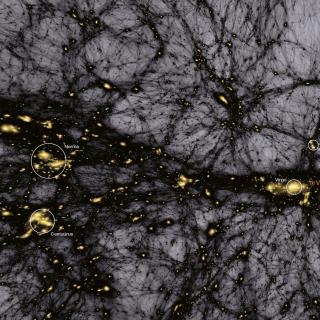Bibcode
López-Sanjuan, C.; Vázquez Ramió, H.; Xiao, K.; Yuan, H.; Carrasco, J. M.; Varela, J.; Cristóbal-Hornillos, D.; Tremblay, P. -E.; Ederoclite, A.; Marín-Franch, A.; Cenarro, A. J.; Coelho, P. R. T.; Daflon, S.; del Pino, A.; Domínguez Sánchez, H.; Fernández-Ontiveros, J. A.; Hernán-Caballero, A.; Jiménez-Esteban, F. M.; Alcaniz, J.; Angulo, R. E.; Dupke, R. A.; Hernández-Monteagudo, C.; Moles, M.; Sodré, L.
Referencia bibliográfica
Astronomy and Astrophysics
Fecha de publicación:
3
2024
Revista
Número de citas
20
Número de citas referidas
12
Descripción
Aims: We present the photometric calibration of the 12 optical passbands for the Javalambre Photometric Local Universe Survey (J-PLUS) third data release (DR3) comprising 1642 pointings of two square degrees each.
Methods: We selected nearly 1.5 million main sequence stars with a signal-to-noise ratio larger than ten in the 12 J-PLUS passbands and available low-resolution (R = 20-80) spectrum from the blue and red photometers (BP/RP) in Gaia DR3. We compared the synthetic photometry from BP/RP spectra with the J-PLUS instrumental magnitudes after correcting for the magnitude and color terms between both systems in order to obtain a homogeneous photometric solution for J-PLUS. To circumvent the current limitations in the absolute calibration of the BP/RP spectra, the absolute color scale was derived using the locus of 109 white dwarfs closer than 100 pc with a negligible interstellar extinction. Finally, the absolute flux scale was anchored to the Panoramic Survey Telescope and Rapid Response System (Pan-STARRS) photometry in the r band.
Results: The precision of the J-PLUS photometric calibration estimated from duplicated objects observed in adjacent pointings and by comparison with the spectro-photometric standard star GD 153 is ~12 mmag in u, J0378, and J0395, and it is ~7 mmag in J0410, J0430, ɡ, J0515, r, J0660, i, J0861, and z. The estimated accuracy in the calibration along the surveyed area is better than 1% for all the passbands.
Conclusions: The Gaia BP/RP spectra provide a high-quality, homogeneous photometric reference in the optical range across the full sky in spite of their current limitations as an absolute reference. The calibration method for J-PLUS DR3 reaches an absolute precision and accuracy of 1% in the 12 optical filters within an area of 3284 square degrees.
Proyectos relacionados

Cosmología con Trazadores de la Estructura a Gran Escala del Universo
El Fondo Cósmico de Microondas (FCM) contiene la información estadística de las semillas primigenias que han dado lugar a la formación de todas las estructuras en el Universo. Su contrapartida natural en el Universo local es la distribución de las galaxias que surgen como resultado del crecimiento gravitatorio de aquellas fluctuaciones de densidad
FRANCISCO SHU
KITAURA JOYANES